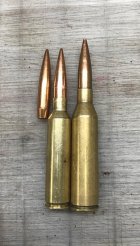How do you determine BC at a mile. I would not know where to begin.
As Skwerlz pointed out, it starts with whatif games with your ballistic solver and what you're after is the shot to shot differences in BC, not the average BC you set the turret with, because the difference is the larger contributor to vertical. By 2 miles, with pretty much anything, it dominates the problem.
If you're looking for something to do out in the middle of nowhere while you wait for your barrel to cool down, play games with your solver to develop a sense of how large something needs to get before it's a problem. I've done it the most at ~2K. More or less, kinda sorta, at 2K 1 moa, 10 fps, and 1% BC variation all contribute about the same amount to the vertical spread. There is no point in working on reducing the group size from 1 moa to 0.5 moa if the next 10 shot string is going to have a 30 fps spread and 3% range in BC. It's more productive to work on the largest problem first.
If you're trying to "true" a solution, air temperature also needs to be considered. 10 F is about the same as a 1% change in BC at 2K. Shooters recognize pretty quickly that the wind at the firing position isn't the same as the wind down range. It's pretty easy to have a 10 degree difference between ground level and it can go either way. Fortunately, the air temperature doesn't change much during a string, so it's not a factor when you're evaluating BC spread.
If you can't find a vertical rock wall, there is another effect that tends to reduce the apparent vertical spread. I call it the danger space effect because I haven't seen a popular colloquial for it yet. I've seen the term "danger space" used in 2 contexts. The first is how much can your range estimate be off and still achieve a hit on a given size target. The second is the distance you need behind a berm to keep people and things safe from shots over the berm. What I'm referring to here is at long distances, there is a large difference in the firing solution between a half mil low hitting just below the target and what appears to be half mil low but is also 20 yards in front. If you've ever heard an account of "I hit a mil low, came up a mil, and still hit a mil low", what really happened was they hit a mil low and 50 yards ahead of the target, then a mil low just ahead of the target. An even more frustrating version is 1 mil, 3:00, no call on the next shot. The first bullet went over the target and hit 25 yards back with enough drop to look like 3:00, the second went over the top and landed in the blind spot behind the target. If you're not setting your own targets, when they ask for volunteers to paint targets, it's in your best interest to go out there and figure out distances to different landmarks at the target.
Tracking BC spread starts with brute force correcting the vertical on each shot for the actual velocity. I use plus or minus 1/2 moa for the error bars. Balancing resolution with potential errors, 2K seems to provide a good balance. It's still just a course estimate though. I'm guessing the BC spread estimate disappears into the fog of the other variables somewhere between 2 and 3%. What you're looking for though is when it pops out above 3%. After a couple barrels, it'll just be that looked like too much vertical for that velocity spread, that range, and these conditions. I'll factor in the round count and changes in velocity since break in.
Where does BC spread come from? Differences in bullet shape or weight are where shooters usually start. The largest bullet to bullet shape difference comes from the difference in meplat size on HP bullets. This is what length sorting is about. In one of the Litz books, AB came up with 1% per 0.010" difference in length for a 200 grain 30 caliber hybrid. That'd need to be scaled for difference calibers, weights, and bullet shapes, but it gives a sense of the size and a starting point for sort criteria. That isn't the end of it or may not even be largest part of it though. All bullets fly with varying amounts of yaw. Some bullets damp it out better than others, reducing the differences as they fly down range. Some bullets don't show as much difference in BC for a given range of yaws. I'm guessing this is what the 15-20% of caliber flat, hard edged, meplats are about with the bullets that are known for low BC spreads. That yaw can also come from the bullet engraving unevenly or being bent as it enters the throat. This only gets worse with wear. Too much pressure can do it as well.
Welcome to the looking glass!











